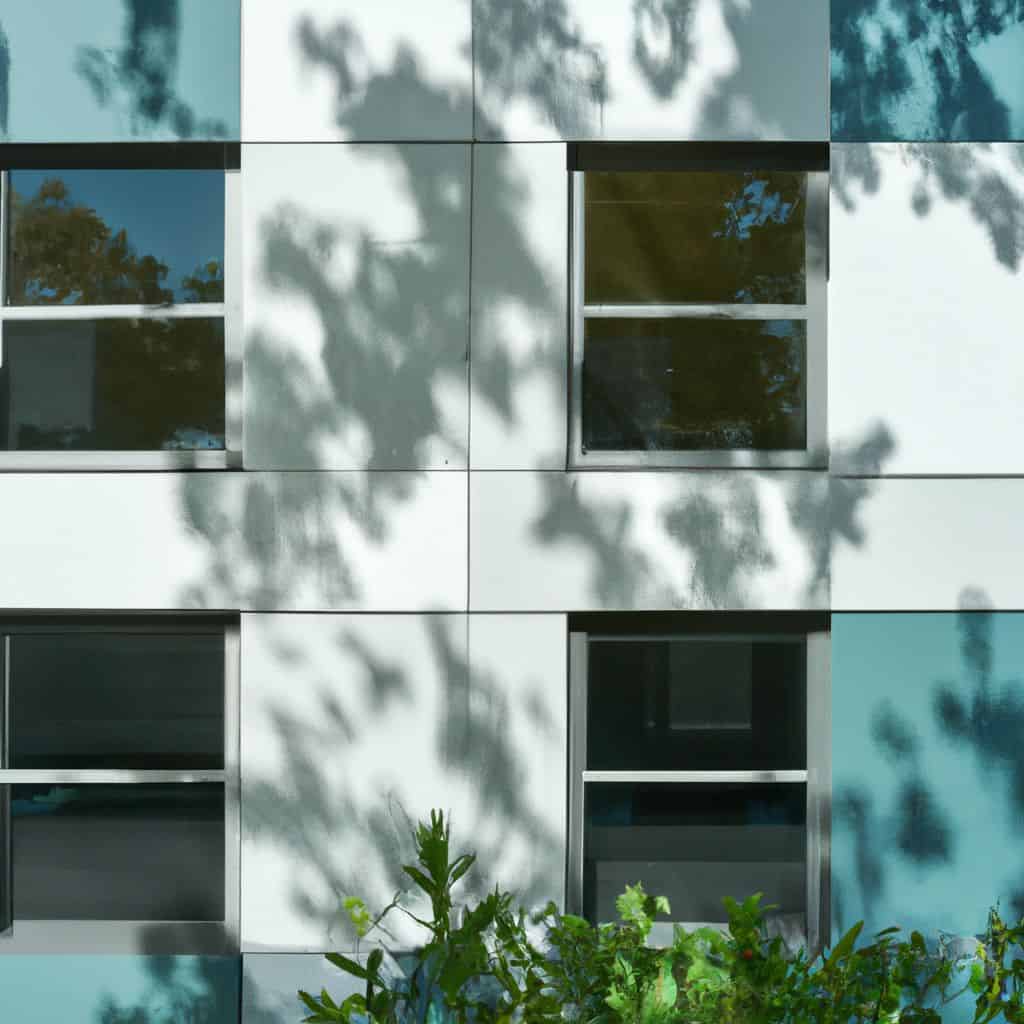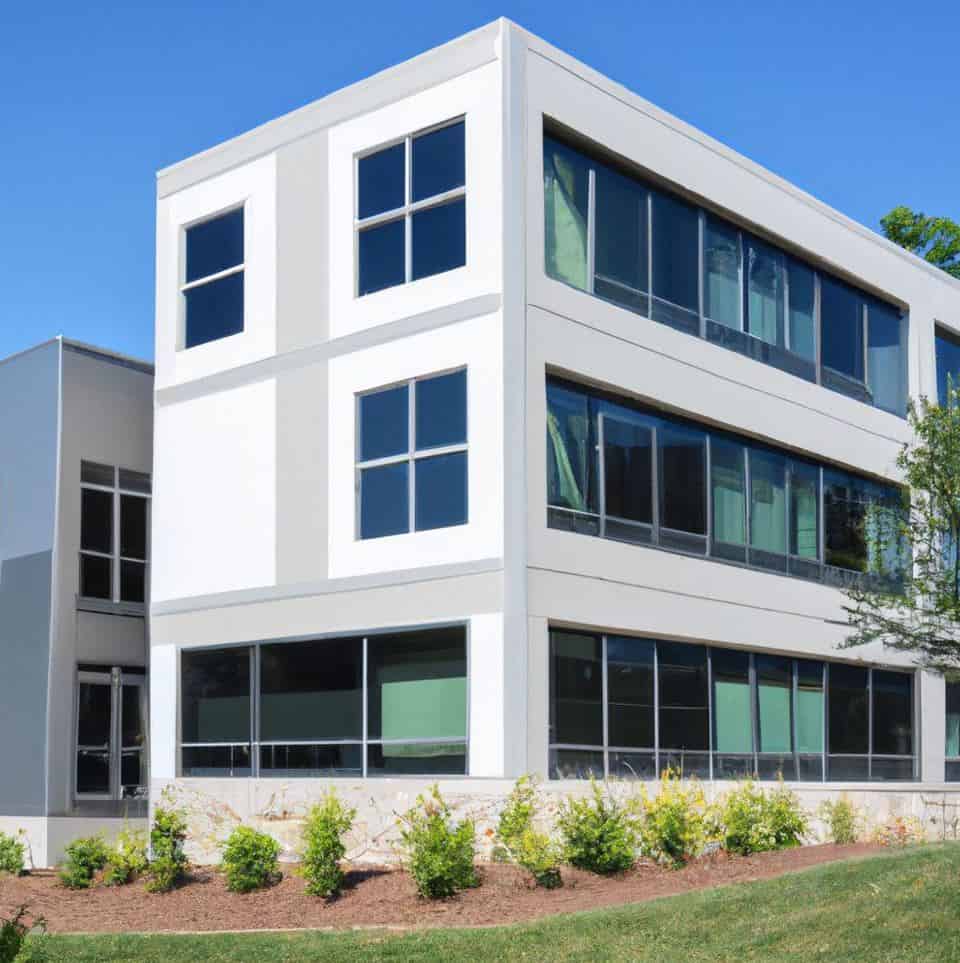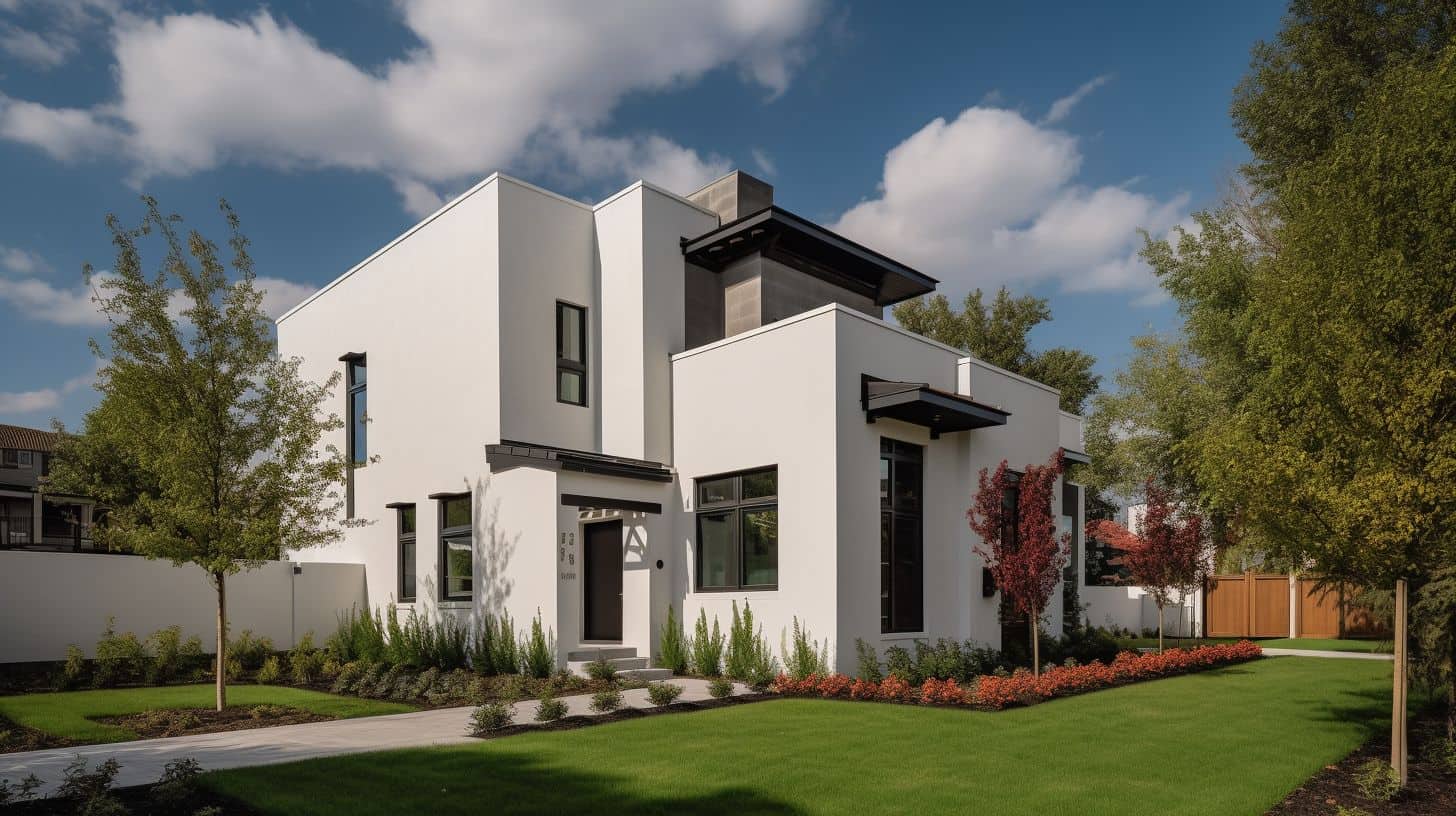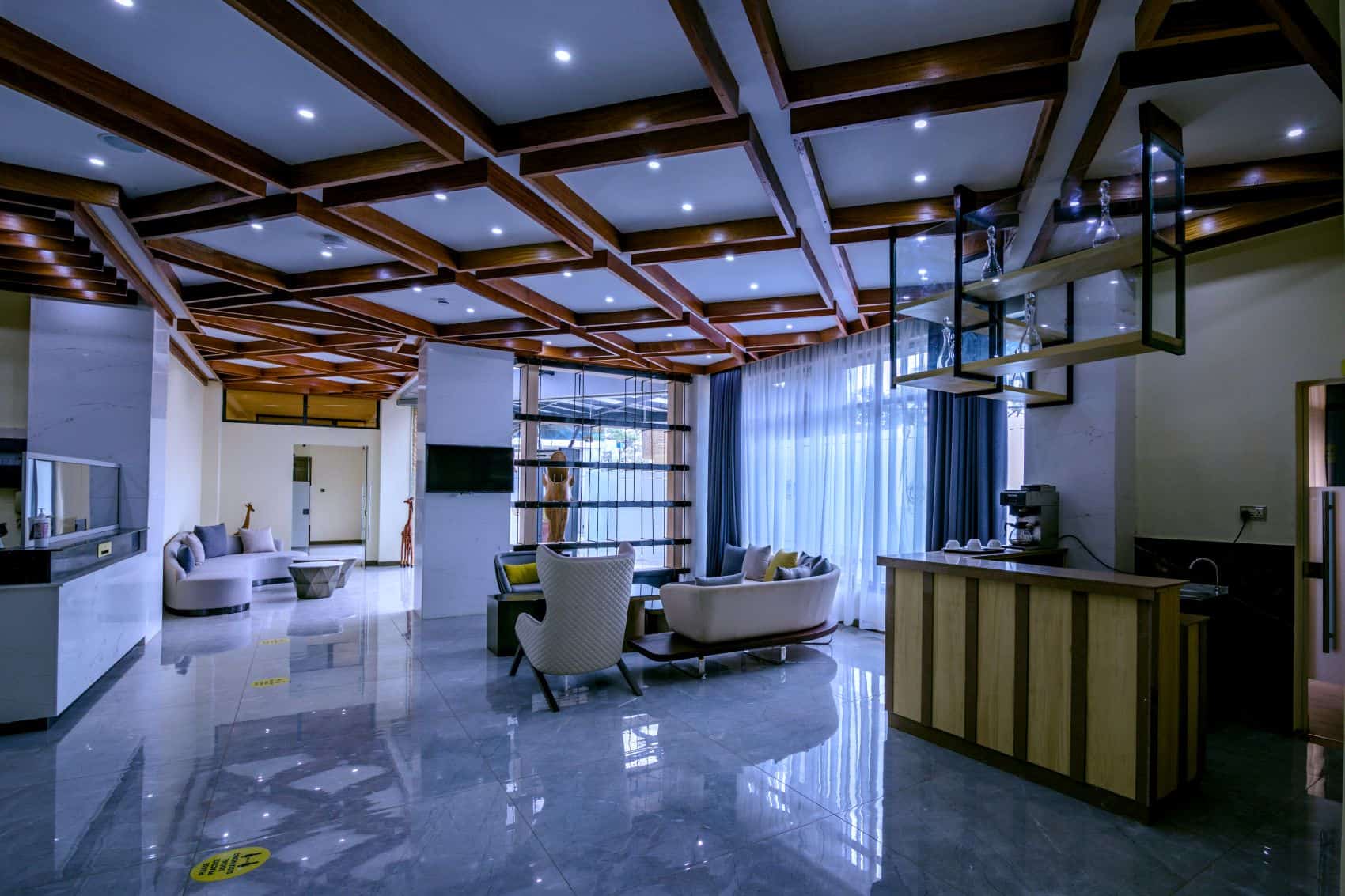Maximizing Green Energy Savings: How EIFS Insulation Complements Solar Panel Technology
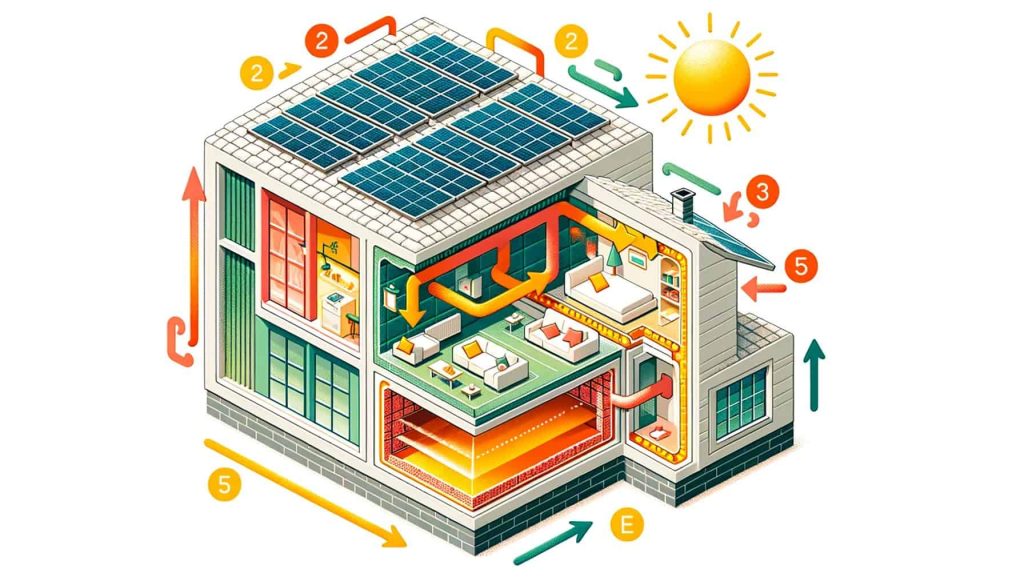
Combining exterior insulation and finishing systems (EIFS) with solar panels creates the ultimate energy-efficient home. EIFS enhances insulation and reduces air infiltration, while solar panels generate renewable electricity from the sun’s rays. Together, they can dramatically lower energy costs and carbon footprint.
How Does EIFS Enhance Energy Efficiency?

EIFS is an insulating wall cladding system composed of several layers that improve thermal performance:
- Adhesive attaches EIFS components to the exterior wall
- Insulation board (typically expanded polystyrene foam) provides high R-value insulation
- Base coat embeds fiberglass mesh for durability
- Finish coat creates a decorative, weather-resistant exterior
This multi-layered system reduces air infiltration through the building envelope. Gaps and cracks allow conditioned air to escape, forcing HVAC systems to work harder. EIFS forms an airtight barrier that prevents drafts.
The thick insulation board also vastly improves insulation. Traditional wood or vinyl siding cannot compete with R-values of R-3.5 to R-5.5 per inch provided by EIFS foam. Better insulation slows heat transfer and reduces energy consumption.
Furthermore, EIFS is a sustainable construction choice because the foam insulation contains recycled material. EIFS facades can also last over 50 years with proper maintenance. A long lifespan coupled with energy savings means fewer resources wasted.
How EIFS Minimizes Air Leaks
Drafts from air leaks can account for 25-40% of home heating and cooling costs. Culprits include:
- Gaps around windows, doors, pipes, wires
- Cracks in foundations, walls, roofs
- Chimneys, recessed lights, fans, outlets
EIFS forms an airtight building envelope that plugs these leaks. The adhesive bonds insulation boards tightly to walls, while sealants caulk edges and joints. This barrier prevents conditioned air from escaping and outside air from infiltrating.
Less air leakage means HVAC systems don’t need to work as hard to compensate for drafts. Your home stays comfortable with lower energy consumption.
The Superior Insulation of EIFS
EIFS insulation boards provide 3 to 5 times the R-value of traditional siding per inch. The exact R-value depends on the thickness and type of foam:
- 1 inch EPS board = R-3.5 to R-4.2
- 1 inch Polyisocyanurate board = R-5.5 to R-6
In contrast, common sidings have the following R-values per inch:
- Brick, stucco = R-0.2
- Wood siding = R-1.25
- Fiber cement = R-0.67
- Vinyl siding = R-1
With an EIFS system, simply adding more foam increases the wall’s total insulation value. This slows heat transfer, reducing demand on HVAC systems for heating and cooling.
Why EIFS is a Sustainable Choice
EIFS offers sustainability benefits in several ways:
- EPS insulation contains recycled plastic material
- Long service life reduces replacement frequency
- Energy savings mean less resource consumption
- Lack of VOC off-gassing enhances indoor air quality
- Minimal site disturbance aids green development
Properly installed and maintained EIFS facades can endure over 50 years. The long lifespan conserves resources that would be wasted replacing other shorter-lived sidings.
Benefits of Using EIFS for Solar Panel Installation
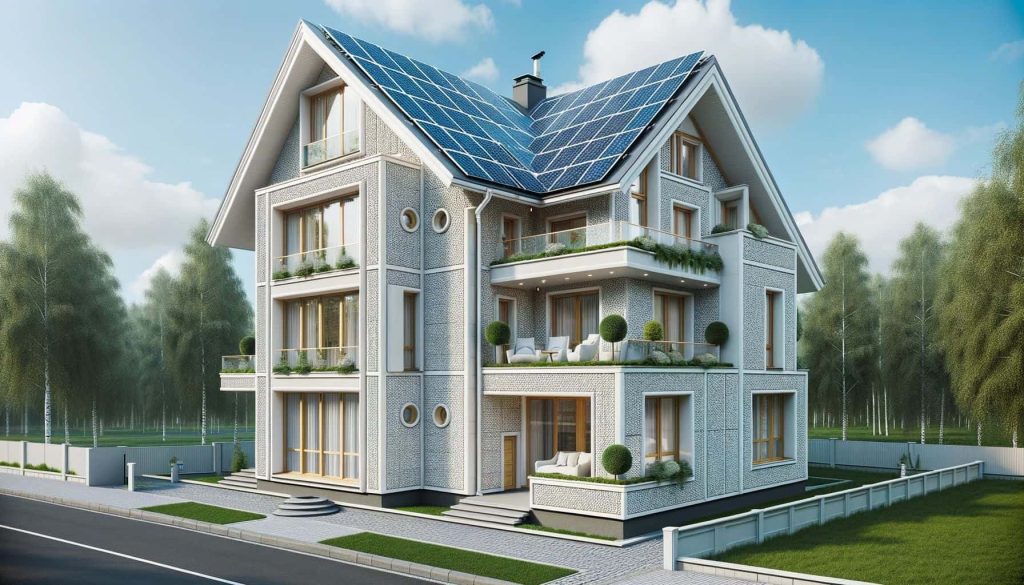
Installing solar panels on an EIFS-clad home offers several advantages:
- Increased energy savings since both technologies maximize efficiency
- Enhanced durability and protection for the solar array
- Aesthetically pleasing and customizable to match the home’s architecture
The high R-value insulation of EIFS helps solar panels operate more efficiently by keeping them cooler in summer and warmer in winter. EIFS also shields the backing wall from moisture, preventing deterioration underneath panels.
With sculpted foam trim options, EIFS allows homeowners to seamlessly incorporate solar panels into the design. Customized finish coat colors and textures complement the modules for beautiful curb appeal.
How EIFS Boosts Solar Panel Efficiency
Solar panels convert sunlight most efficiently within a certain temperature range. In hot weather, high temperatures cause efficiency to drop. In cold weather, output also declines.
EIFS insulation moderates panel temperatures for optimal performance. The R-5 foam keeps solar modules cooler on sweltering summer days. This prevents efficiency from plummeting due to overheating.
In winter, the insulation prevents panels from losing too much heat at night and early morning. By keeping panels warmer, EIFS helps maintain higher efficiency as outside temperatures drop.
EIFS Protects Backing Walls from Moisture
Solar panels installed over EIFS are less likely to cause moisture damage on underlying walls. EIFS foam boards are not a vapor barrier, allowing any condensation or water penetration behind panels to evaporate.
In contrast, installing solar modules over vapor-impermeable siding like vinyl traps moisture against the sheathing. This can cause mold, rot, and wall system failure over time.
EIFS safeguards against deterioration caused by solar panel-related moisture. This protects structural integrity and your investment.
Seamless Integration into Facade Design
EIFS offers almost limitless design flexibility with:
- Hundreds of finish coat colors/textures
- Customized trim and detail options
- Smooth transitions between wall planes
This allows homeowners to artistically incorporate solar arrays into the facade architecture for beautiful curb appeal. Panels can be edged with specialized EIFS trim and finished in complementary colors.
How Does Solar Panel Efficiency Affect Energy Savings?

Solar panel efficiency determines how much of the sun’s energy gets converted into usable electricity. Key factors impacting efficiency include:
- Panel design: Monocrystalline silicon cells (17-22% efficient) outperform polycrystalline (15-18%) and thin-film (~10%).
- Inclination: Tilting panels toward the equator optimizes energy production.
- Materials: Higher-purity silicon and anti-reflective glass increase output.
- Temperature: Cooler panels are more efficient, so ventilation is beneficial.
Over time, solar panels lose some efficiency due to the natural degradation of materials. The industry standard is 0.5-0.8% decline per year. Regular maintenance can mitigate this drop.
Solar panels still generate energy even in cold weather and rain, just at lower efficiency. On sunny winter days, snow often melts off panels, allowing them to produce electricity.
Monocrystalline vs. Polycrystalline Solar Panels
Monocrystalline silicon solar cells have the highest efficiency ratings in the industry, typically between 17-22%. This means they convert a larger percentage of sunlight into electrical energy.
Polycrystalline silicon cells rated 15-18% efficient are almost as good. However, monocrystalline panels tend to output more kilowatt-hours per square meter of solar array area.
Both panel types have similar 30+ year lifespans. Monocrystalline offers slightly better performance, but polycrystalline can be a more economical choice.
Optimizing Solar Panel Positioning
How solar panels are oriented impacts energy production. Some guidelines include:
- Tilt panels 10-15 degrees toward the equator for best angle
- Avoid roof slopes facing north (in the Northern Hemisphere)
- Adjust tilt seasonally if possible for optimal angle
- Keep modules free of shade from trees, chimneys, etc.
Proper orientation maximizes sun exposure so panels generate the most energy possible. Adjacent EIFS walls can provide low-profile tilt platforms.
Do Solar Panels Lose Efficiency Over Time?
Industry data shows solar panels lose 0.5-0.8% of their productive capacity per year as materials naturally degrade. After 25 years, a panel operating at 15% efficiency brand new would decline to around 80% of its original output.
Higher-quality solar modules may degrade slightly less. Periodic maintenance also helps minimize efficiency losses over time. Panel manufacturers typically provide 20-25 year power production guarantees.
Solar Performance in Cold Weather and Rain
Solar panels still generate some electricity in winter and rainy conditions despite lower radiation. Here’s what to expect:
- Colder temperatures reduce output by up to 20%
- Snowfall brings production to a halt until melted
- Raindrops cause a small 2-5% drop in efficiency
- On sunny winter days, snow often melts even if ambient temperatures are low
Seasonal efficiency changes are factored into overall solar system design. Output is typically ample even on cloudy, wet days. EIFS insulation helps minimize extreme cold weather losses.
The Costs of Going Solar

While sunlight is free, installing and maintaining a solar array requires an investment. Key costs include:
- Installation: $15,000 to $25,000 depending on system size, roof type, permitting fees, and more. Federal tax credit cuts expenses by 26%.
- Maintenance: $100 to $400 annually for system monitoring, cleaning panels, and replacing inverters/wiring.
- Environmental: Manufacturing solar panels consumes energy and resources, but the systems typically offset this within 3-4 years.
Fortunately, net metering policies and solar renewable energy credits provide additional savings to help offset the initial outlay.
Solar Panel Installation Cost Breakdown
For a 5 kW residential system, typical installation costs include:
- Solar panels – $9,000 to $12,000
- Inverters – $2,000 to $3,000
- Racking and wiring – $2,000 to $3,000
- Permits/fees – $500 to $1,000
- Labor – $2,000 to $3,000
Costs are higher for larger or more complex installations. Luxury systems with premium equipment and customized racking can run $30,000 or more.
Federal Solar Tax Credit Savings
The federal solar tax credit offers a 26% deduction on installation costs through 2032. For a 5 kW system costing $18,000, this equals $4,680 in tax savings.
Some states and utilities also offer rebates to further offset the price. These incentives make solar power a smarter investment.
Solar Panel Maintenance Costs
Expect to budget $100 to $400 per year for:
- System monitoring – $150 to $300
- Panel cleaning – $50 to $100
- Inverter replacement – $2,000 to $3,000 every 10-15 years
- Wiring repairs as needed
Routine maintenance ensures your system operates efficiently. EIFS helps reduce panel soiling compared to other sidings.
How Net Metering and SREC Market Contribute to Cost Savings
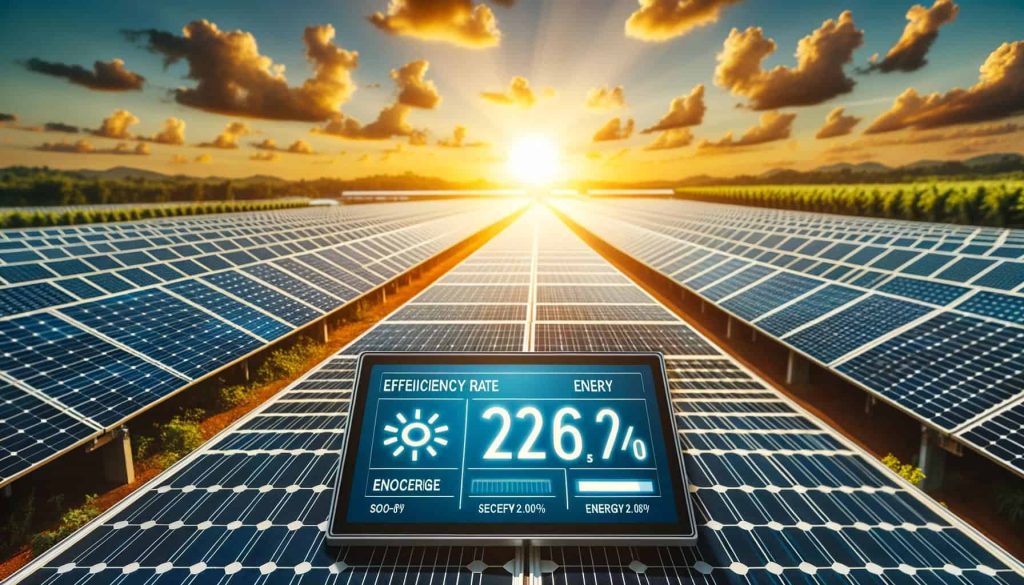
Net metering and the SREC market make solar power generation more financially viable:
Net metering allows solar homeowners to get credit for excess energy fed into the grid. The home’s electric meter spins backward as solar electricity is exported, offsetting power drawn from the utility when solar production is low. This arrangement lowers bills.
The Solar Renewable Energy Certificate (SREC) market is another avenue for recouping costs. For each 1,000 kWh produced, solar panel owners earn one SREC which they can sell to utility companies. Prices fluctuate but average $150-$300 per SREC.
How Net Metering Works
With net metering, your main utility meter tracks net energy use, not total solar production and consumption separately.
When your solar array generates more power than you need, the surplus gets fed into the grid. Your meter spins backward to log these exports at the retail electricity rate.
At night or on cloudy days when solar output is low, your home pulls energy from the grid as usual. But the net metering credits you’ve banked offset this draw.
Monthly bills reflect net energy consumption from the grid after solar exports are deducted. This saves money compared to no solar.
Understanding the SREC Market
SREC stands for Solar Renewable Energy Certificate and represents 1,000 kWh of solar power produced.
For each SREC earned, solar homeowners can sell these certificates on the open market to utility companies seeking renewable energy sources.
SREC prices vary based on supply and demand dynamics by state. Typical rates range from $150 to $300 per certificate.
The revenue generated helps recoup solar installation costs. An average 5 kW system might earn 5 to 10 SRECs per year.
The Benefits of Going Solar
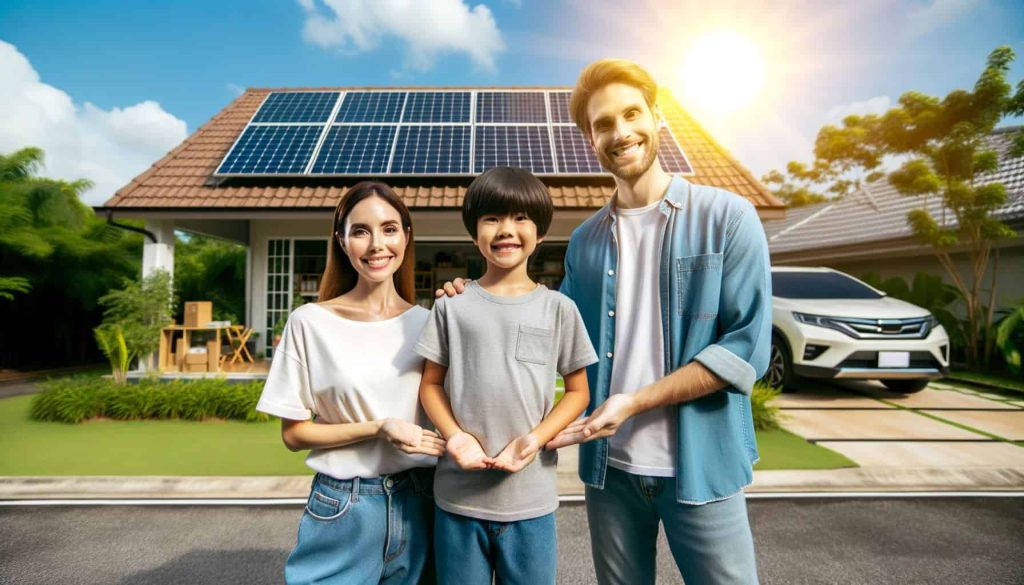
Beyond the cost savings, solar power provides other meaningful benefits. Homeowners who’ve gone solar share their experiences:
“Adding solar panels to our EIFS-clad house let us take control of our energy costs. We’ve eliminated our $150 monthly electric bill thanks to net metering credits. The extra money goes toward paying down the solar loan until the system is paid off in 7 years.”
“I love that we’re using clean energy from the sun instead of fossil fuels. It feels great knowing we’re doing our part to reduce greenhouse gas emissions.”
“The solar array gave our aging home a much needed style upgrade. The sleek black panels look modern against the pearl white EIFS facade.”
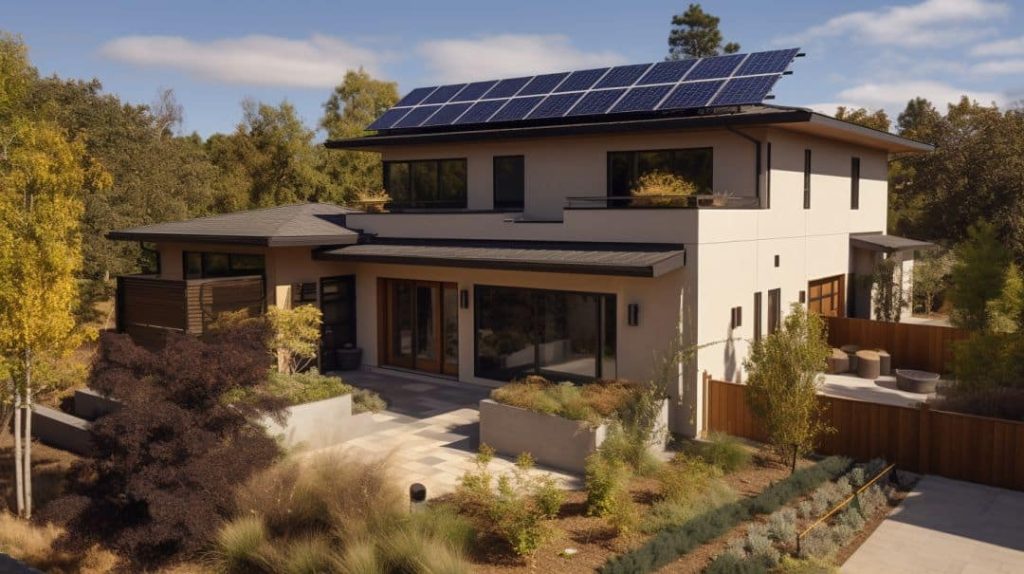
Lower Energy Bills Through Net Metering
Many solar adopters highlight slashing their energy bills as a prime benefit. Typical savings range from 40% to 100% or more, depending on system size, net metering policy, and energy consumption patterns.
Even if your solar system doesn’t wipe out bills completely, substantially lower charges provide savings that help justify the installation cost.
Making an Environmental Impact
Rising climate change awareness drives many homeowners to go solar. Typical residential solar systems offset 30,000 to 40,000 pounds of CO2 annually if displacing fossil fuel power plants. This equals planting hundreds of trees.
Solar adopters enjoy knowing their lifestyle choices to help protect the planet. EIFS further enhances environmental savings through insulation.
Curb Appeal and Property Value Boost
Solar arrays add eye-catching style to homes, blending modern technology with timeless energy from the sun. EIFS facades offer the perfect canvas for seamlessly incorporating panels.
This tech-forward look helps attract buyers interested in energy-saving features. Multiple studies show solar can raise the home resale value by about 4% on average.
Combining EIFS and Solar Panels: The Perfect Match for Energy Efficiency
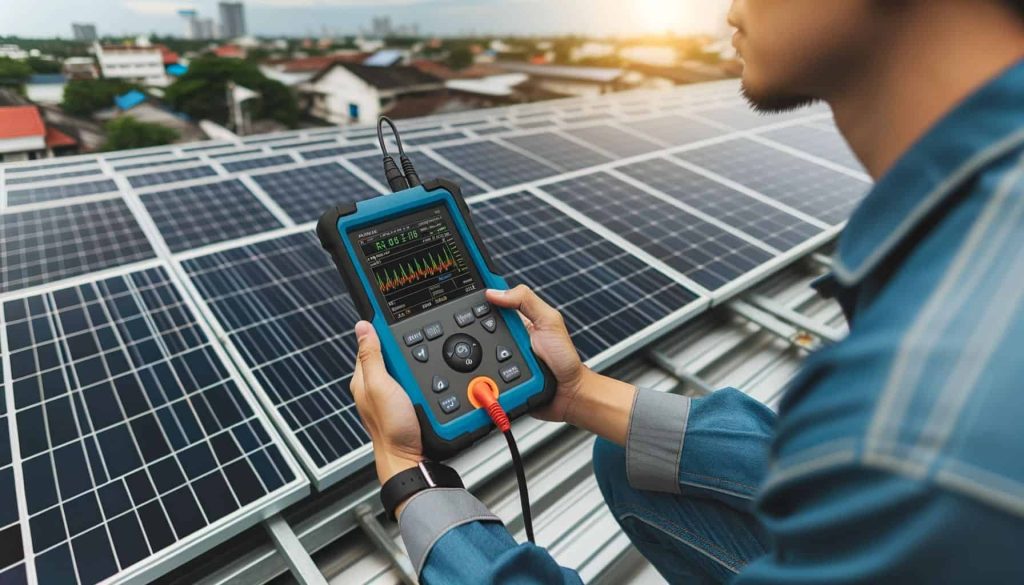
Together, EIFS and solar PV systems are a dynamic duo when it comes to energy savings. Here are some of the biggest benefits of this winning combination:
- The thermal efficiency of EIFS insulation enables solar panels to operate at optimal temperatures for maximum output.
- EIFS weather-resistant barrier protects backing walls from moisture that could seep behind panels and cause deterioration.
- Sculpted EIFS trim options allow for seamless, aesthetically pleasing integration of solar arrays into the facade design.
- Custom EIFS finishes like acrylic coats and aggregate can visually complement the appearance of solar panels.
- An EIFS-clad home needs less energy input from HVAC systems, allowing more solar power to be exported to the grid for net metering credits.
- EIFS facades can last over 50 years, providing durable backing for solar PV systems that typically have 25-year lifespans.
Optimizing Solar Panel Efficiency
Proper siting and orientation is key, but EIFS gives solar panels an added performance boost. The insulation moderates panel temperatures for ideal output in all seasons.
Warmer in winter, cooler in summer – EIFS helps solar modules operate closest to their optimal temperature sweet spot all year round.
Safeguarding Backing Walls
Severe moisture damage sometimes occurs behind poorly flashed solar arrays. With EIFS, breathable foam insulation allows any moisture to dry without trapping it against the vulnerable sheathing. No worries about decay.
Design Flexibility for Perfect Integration
Take advantage of EIFS’s limitless color and texturing possibilities to create a facade that seamlessly incorporates solar panels. With custom trim and finishes, the possibilities are endless.
Leveraging Energy Synergies
Super-insulated EIFS construction requires less power drawn from HVAC systems. More solar energy can be diverted to net metering credits rather than home consumption. It’s a win-win.
Conclusion
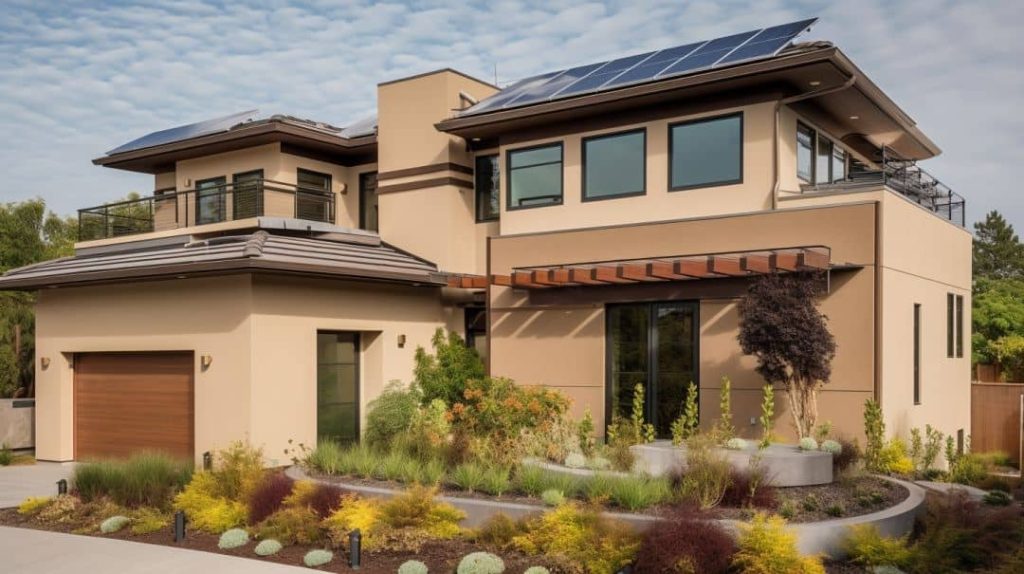
EIFS super-insulated wall systems plus solar PV arrays are a winning combination when it comes to energy efficiency. EIFS enhances solar panel performance while providing durable, customizable backing crucial for a sound installation. Together, these technologies minimize energy costs and environmental impact.
Contact Indiana Wall Systems here for expert EIFS installation and repair services to support your solar panel project. Our team brings over 35 years of experience delivering innovative solutions that extend building lifespans and enhance sustainability. Discover how we can help you achieve your vision for an energy-efficient dream home.
FAQs
How does EIFS protect my solar panel investment?
EIFS insulation boards allow any moisture that gets behind solar panels to evaporate rather than trapping it against vulnerable sheathing materials. This prevents deterioration of the underlying walls, protecting structural integrity. EIFS adds durability and enhances lifespan.
What EIFS finish is best for integrating solar panels?
Using EIFS coatings in colors that visually complement the solar modules creates a cohesive facade design. Darker earth tones work well with black panels. Matte or sand-textured finishes help avoid glare while providing an elegant contrast.
Can I install solar panels directly over my existing EIFS walls?
Yes, EIFS provides durable, protective backing for solar arrays. The insulation boards stand up well to the elements over decades. Be sure to involve your EIFS installer for proper flashing details around panels.
How does EIFS help my solar panels work more efficiently?
The high R-value of EIFS insulation keeps solar modules at optimal operating temperatures. Warm in winter to maintain output but cool in summer to prevent overheating efficiency losses. Temperature modulation maximizes solar electricity generation.
Do I still get energy savings by adding solar panels to my EIFS home?
Absolutely. While EIFS provides insulation and draft-stopping, it does not generate renewable energy like solar panels. Combining these two technologies allows you to realize savings from both improved efficiency and reduced grid dependence.

